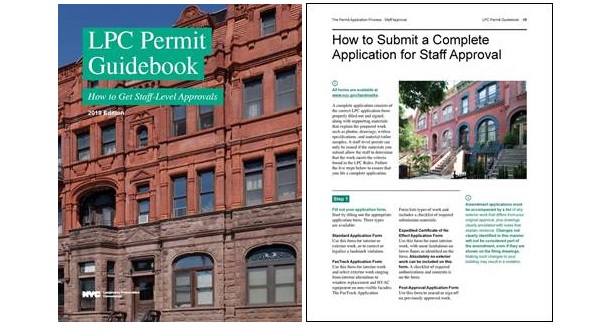 Today, the New York City Landmarks Preservation Commission (LPC) launched an updated edition of the Permit Application Guide, now named the LPC Permit Guidebook: How to Get Staff-Level Approvals.
Today, the New York City Landmarks Preservation Commission (LPC) launched an updated edition of the Permit Application Guide, now named the LPC Permit Guidebook: How to Get Staff-Level Approvals.
This includes new application forms to make it easier for property owners and tenants looking to do work on landmark properties. The enhanced guidebook and application forms are designed to help applicants understand the Commission’s processes and rules and the information needed to submit a complete application so they can get their permits as quickly as possible.
“As Chair, my goal is to make the agency’s processes clear and fair, and ensure that appropriate work is approved as quickly as possible, which is why we updated the LPC Permit Guidebook and application forms,” said Landmarks Preservation Commission Chair Sarah Carroll. “Preservation is a partnership between owners, their agents, and LPC, and by making this information more accessible and the process easier, we can make the preservation of New York City’s rich historic and architectural heritage a success.”
The LPC Permit Guidebook is meant to provide applicants with a clear explanation of the Commission’s processes and rules for all of the most common work types, and what is required to get staff approval — the fastest way to get a permit. It breaks down the application process into simple steps, outlines and illustrates the rules and criteria for staff-level-approval, and identifies what materials need to be included in the initial application submission so that staff can quickly review and issue the permit.
The updated guidebook, which reflect the new rules and amendments adopted by the Commission in January 2019, focuses on the most common types of work that require a permit, such as window replacement, restoration and additions. It includes new guidance on barrier-free access in order to ensure buildings are accessible, and, for the first time, it also addresses sustainability, resiliency and flood-proofing measures in historic buildings so they may best adapt to the impacts of climate change. The guidebook can be downloaded as a comprehensive document or by chapter. The revision and design of the guidebook were supported by a grant from the New York State Office of Parks, Recreation, and Historic Preservation.
The new application forms are intended to be clearer and more user-friendly to help applicants understand what forms they need to fill out when applying for a permit and what they need to submit with their forms to ensure their application is complete upon submission.
LPC updated its standard review and expedited review application forms, and introduced a new form for post-approval actions related to the original permit approval. There are now four application forms available: the Standard Application Form, which can be used for interior or exterior work or to correct or legalize a landmark violation; the FasTrack Application Form, which can be used for interior work and select exterior work; the Expedited Certificate of No Effect Application Form, which can be used for select interior work only; and the Post-Approval Application Form, which can be used to amend or sign off on previously approved work or to submit filing drawings for Certificate of Appropriateness. The agency also updated its homeowner and non-profit application forms for the Historic Preservation Grant Program, which provides façade restoration grants to income-eligible owners of landmark properties and non-profit organizations. Over the next few months, LPC will be doing outreach events to present the new guidebook and forms.
“The completion of the new Landmarks Preservation Commission’s updated permit guidebook sets a model for preservation commissions statewide,” said Daniel Mackay, Deputy Commissioner for Historic Preservation at the New York State Office of Parks, Recreation and Historic Preservation. “Many municipalities in Long Island and upstate draw influence from LPC’s administration of historic resources. By partnering on the this new resource, the New York State Historic Preservation Office hopes to share the guidebook with other commissions looking to adopt these best practice procedures for working with the public.”
“The new Landmarks Preservation Commission’s Permit Guidebook will significantly ease the process of getting approvals for design work on historic projects,” said Benjamin Prosky, Executive Director of the American Institute of Architects (AIA) New York. “I am confident that this will expedite approvals of critical restoration work on more of New York’s cherished landmarked buildings and structures, many of which are in desperate need of immediate repairs.”
The Landmarks Preservation Commission is the mayoral agency responsible for protecting and preserving New York City’s architecturally, historically and culturally significant buildings and sites. Since its creation in 1965, LPC has granted landmark status to more than 37,000 buildings and sites, including 1,435 individual landmarks, 120 interior landmarks, 11 scenic landmarks, and 149 historic districts and extensions in all five boroughs. For more information, visit www.nyc.gov/landmarks and connect with us via www.facebook.com/NYCLandmarks and www.twitter.com/nyclandmarks.
Become a Harlem Insider!
By submitting this form, you are consenting to receive marketing emails from: . You can revoke your consent to receive emails at any time by using the SafeUnsubscribe® link, found at the bottom of every email. Emails are serviced by Constant Contact








